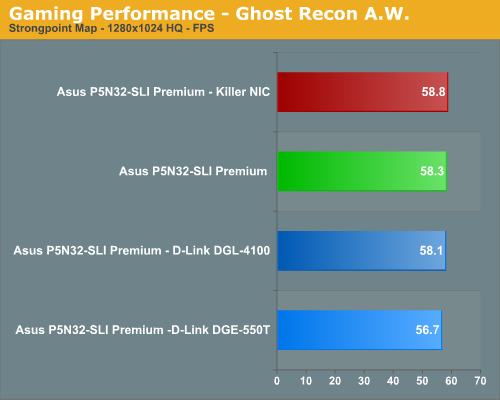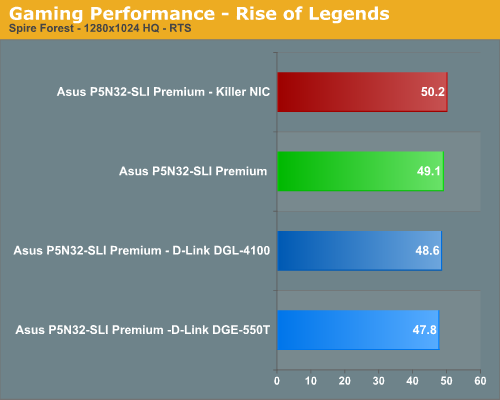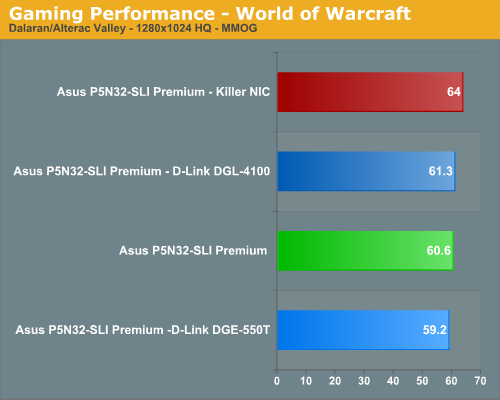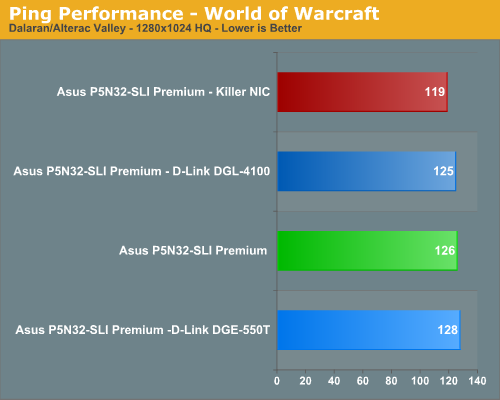BigFoot Networks Killer NIC: Killer Marketing or Killer Product?
by Gary Key on October 31, 2006 2:00 AM EST- Posted in
- Networking
Ghost Recon: Advanced Warfighter
While not the most popular online shooter this game has picked up steam lately with the 1.3 patch. We are playing on the Strongpoint map with a total of 12 players. Our video resolution is at 1280x1024 HQ and we found this game to be very playable at frame rates above 40 fps. The servers we connected with were generally showing ping rates around 45ms to 60ms at the time of connection.

We see a very slight frame rate improvement in this game but nothing that was noticeable during game play. It was difficult to tell any differences in game play between each product and as far as we could tell all systems played the game in a similar manner. If we had to make a choice we would choose the NVIDIA nForce 590SLI NIC as it seemed a tad bit smoother in certain areas.
Company of Heroes
Company of Heroes is one of our favorite RTS games around the office. We are playing the Lorraine map in one versus one player mode. Our other test party hosted the game and we found their system configuration to be nearly identical to ours. Our resolution was set to 1280x1024 with all options on high except for AA. This game is very playable with frame rates above 35 fps in multiplayer action.

Bigfoot Networks stated to us early on not to expect any measureable performance differences in the majority of RTS games. Sure enough we did not see any improvements although the Killer NIC did score a little higher than our D-Link solutions. Once again, we did not notice any real differences in game play between any of the products. We actually tried the Killer NIC in APP mode and were greeted with basically the same level of performance.
Rise of Legends
This game was released a few months back and like most real time strategy games is very CPU intensive but still offers a very visual experience. In order to experience the game properly you need a fast CPU, very good memory subsystem, and a decent GPU to play at the higher resolutions. This is one game that seems to have the perfect recipe for the Killer NIC. We are playing the Spire Forest map with Vinci versus Vinci. We generally found the game to be enjoyable with an average frame rate above 40 fps.

Although BigFoot Networks had stated most RTS games will not show any improvements we see a slight increase in frame rates with this game. We have to temper our results with the fact that there was not any noticeable difference in game play between the various products once again. In a blind performance test, any setup could have won for the most enjoyable game play experience.
World of WarCraft
WoW is the largest and probably most enjoyable MMO we have played and is a favorite amongst many of our staff members. This is another title that BigFoot Networks has explicitly stated will show performance improvements and is one that is mentioned in most of their marketing materials. We logged in at several different times that range from Wednesday morning to late night Saturdays to ensure we experienced a wide variety and number of players on the server. We started in the Dalaran Ruins and traveled to the Alterac Valley battlegrounds doing our best to battle the same creatures with each character.


We see about a 4% increase over our other products in frame rates. WoW is basically capped at 64 fps with dual core systems so it is difficult to determine if the Killer NIC would provide any further frame rate increases with our test platform. We have seen increases quoted in the 10% or plus range in this game so we utilized a 3.4GHz P4 in our test bed and noted a 9% increase in frame rates. The Killer NIC gets a point for increasing frame rates as advertised. Of course anything over 35 fps in this game is very playable so the increases while nice did not really improve our game play.
Ping rates did improve by up to 7% (host system improvements and server variables) and this is where we did notice a difference in game play during the busy test sessions on Friday and Saturday nights. When our area was full of players we did notice smoother game play at times with the Killer NIC. This did not happen when we were basically the only characters playing in certain sections. This game is designed to a certain degree for higher ping rates so there is some balancing that is already done by the server during combat. Overall, the Killer NIC performed almost as advertised in this benchmark.
In order to make sure we were not drinking the Snake Oil we did a blind performance test in WoW with a third party. The third party had no idea their on-board NIC had been replaced with the Killer NIC. The first reaction was a question asking if an additional one gigabyte of RAM had been added to the system or if the video card had been changed. This would normally make for very good publicity and we found it slightly amazing that someone would pick up on the differences in performance so quickly. However, this configuration was a dual core CPU based mid-range system and the user would not be one to spend $279.99 on a peripheral other than a new graphics card. If someone had offered them this card for $50 in order to improve their WoW experience they probably would have jumped at it instead of gasping when told the actual price.
While not the most popular online shooter this game has picked up steam lately with the 1.3 patch. We are playing on the Strongpoint map with a total of 12 players. Our video resolution is at 1280x1024 HQ and we found this game to be very playable at frame rates above 40 fps. The servers we connected with were generally showing ping rates around 45ms to 60ms at the time of connection.

We see a very slight frame rate improvement in this game but nothing that was noticeable during game play. It was difficult to tell any differences in game play between each product and as far as we could tell all systems played the game in a similar manner. If we had to make a choice we would choose the NVIDIA nForce 590SLI NIC as it seemed a tad bit smoother in certain areas.
Company of Heroes
Company of Heroes is one of our favorite RTS games around the office. We are playing the Lorraine map in one versus one player mode. Our other test party hosted the game and we found their system configuration to be nearly identical to ours. Our resolution was set to 1280x1024 with all options on high except for AA. This game is very playable with frame rates above 35 fps in multiplayer action.

Bigfoot Networks stated to us early on not to expect any measureable performance differences in the majority of RTS games. Sure enough we did not see any improvements although the Killer NIC did score a little higher than our D-Link solutions. Once again, we did not notice any real differences in game play between any of the products. We actually tried the Killer NIC in APP mode and were greeted with basically the same level of performance.
Rise of Legends
This game was released a few months back and like most real time strategy games is very CPU intensive but still offers a very visual experience. In order to experience the game properly you need a fast CPU, very good memory subsystem, and a decent GPU to play at the higher resolutions. This is one game that seems to have the perfect recipe for the Killer NIC. We are playing the Spire Forest map with Vinci versus Vinci. We generally found the game to be enjoyable with an average frame rate above 40 fps.

Although BigFoot Networks had stated most RTS games will not show any improvements we see a slight increase in frame rates with this game. We have to temper our results with the fact that there was not any noticeable difference in game play between the various products once again. In a blind performance test, any setup could have won for the most enjoyable game play experience.
World of WarCraft
WoW is the largest and probably most enjoyable MMO we have played and is a favorite amongst many of our staff members. This is another title that BigFoot Networks has explicitly stated will show performance improvements and is one that is mentioned in most of their marketing materials. We logged in at several different times that range from Wednesday morning to late night Saturdays to ensure we experienced a wide variety and number of players on the server. We started in the Dalaran Ruins and traveled to the Alterac Valley battlegrounds doing our best to battle the same creatures with each character.


We see about a 4% increase over our other products in frame rates. WoW is basically capped at 64 fps with dual core systems so it is difficult to determine if the Killer NIC would provide any further frame rate increases with our test platform. We have seen increases quoted in the 10% or plus range in this game so we utilized a 3.4GHz P4 in our test bed and noted a 9% increase in frame rates. The Killer NIC gets a point for increasing frame rates as advertised. Of course anything over 35 fps in this game is very playable so the increases while nice did not really improve our game play.
Ping rates did improve by up to 7% (host system improvements and server variables) and this is where we did notice a difference in game play during the busy test sessions on Friday and Saturday nights. When our area was full of players we did notice smoother game play at times with the Killer NIC. This did not happen when we were basically the only characters playing in certain sections. This game is designed to a certain degree for higher ping rates so there is some balancing that is already done by the server during combat. Overall, the Killer NIC performed almost as advertised in this benchmark.
In order to make sure we were not drinking the Snake Oil we did a blind performance test in WoW with a third party. The third party had no idea their on-board NIC had been replaced with the Killer NIC. The first reaction was a question asking if an additional one gigabyte of RAM had been added to the system or if the video card had been changed. This would normally make for very good publicity and we found it slightly amazing that someone would pick up on the differences in performance so quickly. However, this configuration was a dual core CPU based mid-range system and the user would not be one to spend $279.99 on a peripheral other than a new graphics card. If someone had offered them this card for $50 in order to improve their WoW experience they probably would have jumped at it instead of gasping when told the actual price.










87 Comments
View All Comments
Gary Key - Wednesday, November 1, 2006 - link
We have been trying to develop a benchmark for BF2142 and our issues always revolve around the Titan when it is full. ;-) I tried BF2142 right before we ended testing with the Killer NIC and could not tell any difference with it. However, I did not benchmark while we were trying to develop a benchmark. If I get a chance I will go back and try it with the new drivers.soydeedo - Wednesday, November 1, 2006 - link
cool beans. thanks for that quick first impression. i was just curious if it could somehow benefit from the packet optimization etc. anywho, keep us posted should you find something noteworthy with the new drivers. =)goinginstyle - Wednesday, November 29, 2006 - link
Any update on BF2142?Nehemoth - Tuesday, October 31, 2006 - link
Now i just need that anandtech review thishttp://www.hfield.com/wifire.htm">http://www.hfield.com/wifire.htm
yyrkoon - Wednesday, November 1, 2006 - link
Looks like a flat panel, and you'd do better with a 21-23DB gain Andrew, trust me, I've had the last two years to play with both since we've been wireless internet for about that long. We have just now switched (tonight, just got he hardware) to AT&T 'Wi-Max', and it is much much better than our previous provider using 802.11/G. Get this, it doesnt even need a dirrectional, just set it next to a window (such is true in our case), and you're getting an instant 2.52Mbit from a tower 8 miles away.It's pretty dahmed cool, and I didnt believe it myself, until I hooked up a neibors system for him, and he's got it in a window that sits on the opposite side of his house from the tower. Although, from the little technical information the tech support team was able to provide me with, it's only availible in our town, and only if you cant get DSL, supposedly, this is some sort of trial service for them, to determine whether its feasable to setup in other areas *shrug*. Nothing like downloading at 200 KB/s +, seen it swing as high as 800+ KB/s
feelingshorter - Tuesday, October 31, 2006 - link
Buddy, that thing is realistic. Dont tell me you never herd of a directional antenna?!?!? Thats all it is. No its not overpriced because good antennas cost a lot and it does stop your internet from dropping.Frumious1 - Tuesday, October 31, 2006 - link
Only problem is it's completely impractical for laptops where you move around a lot. For desktops, if you want a consistent quality connection, just run the damn wire and be done with it. The fastest wireless 802.11 stuff can't even come close to 100 Mbit for typical use, let alone gigabit!yyrkoon - Tuesday, October 31, 2006 - link
I have to admit, I'm a bit disappointed in you fellas, for not even benching the in-expensive Intel PCI-E NIC http://www.tigerdirect.com/applications/searchtool...">Intel Pro 1000 PCI-E, Or atleast comparring the two. For $40 USD, this card should perform very close, if not better than the $300usd 'snake oil' NIC.
*sigh*
Gary Key - Tuesday, October 31, 2006 - link
We tested the Intel PRO/1000 PT and the Koutech PEN120 PCI-Express Gigabit adapters. Both adapters scored slightly less than the NIVIDIA NIC across the board in our tests so we did not show the results. Both cards support Linux so that is a plus but then again we were reviewing a NIC designed for Windows based gaming.yyrkoon - Wednesday, November 1, 2006 - link
Hmm, guess i missed that review, however, the last review on saw on the Intel PCI, and Onboard Intel solutions (a year or so ago from *ahem* THW, showed both those leading the pack, of course, I guess the killer NIC wasnt availible at that time . . .